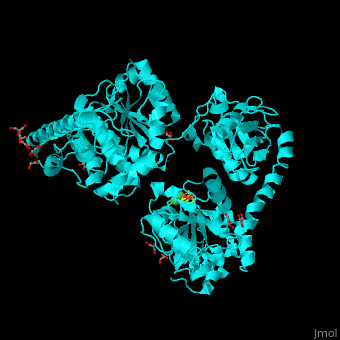Acetyl-CoA synthase
From Proteopedia
(Difference between revisions)
| Line 8: | Line 8: | ||
* '''ACS-III''' uses pyruvate as the source of CO2 and 2 electrons to produce acetyl-CoA.<br /> | * '''ACS-III''' uses pyruvate as the source of CO2 and 2 electrons to produce acetyl-CoA.<br /> | ||
* '''ACS-IV''' catabolizes CO to CO2. <br /> | * '''ACS-IV''' catabolizes CO to CO2. <br /> | ||
| - | ACS can form a bifunctional entity with carbon monoxide dehydrogenase ('''CODH/ACS'''). CODH/ACS is part of the Woods-Ljungdahl pathway of carbon fixation using CO and methyl group to produce acetyl-CoA. | + | ACS can form a bifunctional entity with [[carbon monoxide dehydrogenase]] ('''CODH/ACS'''). CODH/ACS is part of the [[Woods-Ljungdahl pathway]] of [[carbon fixation]] using CO and methyl group to produce acetyl-CoA. |
== Structural highlights == | == Structural highlights == | ||
Revision as of 15:50, 26 January 2023
| |||||||||||
References
- ↑ Svetlitchnyi V, Dobbek H, Meyer-Klaucke W, Meins T, Thiele B, Romer P, Huber R, Meyer O. A functional Ni-Ni-[4Fe-4S] cluster in the monomeric acetyl-CoA synthase from Carboxydothermus hydrogenoformans. Proc Natl Acad Sci U S A. 2004 Jan 13;101(2):446-51. Epub 2003 Dec 29. PMID:14699043 doi:10.1073/pnas.0304262101

